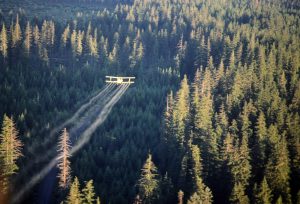
Pesticides are being sprayed on Canadian forests, killing the diversity of forest life. The resulting harms are plant and animal death, destruction of forest foods, and accelerating forest fires.
How is this allowed?
- The approval for this use of pesticides comes from the agency responsible for “managing pests” – the Pest Management Regulatory Agency (PMRA) of Health Canada. The licenses to spray are then granted by the provinces.
- PMRA says that unwanted trees and brush are “pests”. Pests are defined in the “Pest Control” law to include “a plant… that is injurious, noxious or troublesome”.
- So trees are a troublesome pest? The forest industry and PMRA think they are. The aim of industry is to “harvest” one type of tree “crop”, usually evergreens (conifers), and get rid of the leafy trees (broadleaf) that get in the way – the pests.
The PMRA Glyphosate Approval
- Glyphosate is the pesticide mostly used on Canadian forests, approved for use on forests by PMRA in preliminary and final approval documents (PRVD 2015-01 and RVD2017-01).
- PMRA in its approval says the value of glyphosate in forestry is:
It can be applied at various stages in the forest regeneration cycle including site preparation, conifer release and stand thinning stages. (PRVD p.43)
- “Site preparation” means killing unwanted forest growth (mostly leafy trees). “Conifer release” means “releasing” conifers from competition from other growth. “Thinning” means killing some of the desired planted trees.
Unfounded Assumption
- PMRA’s approval is based on the assumption that glyphosate is used only once every 50 to 80 years on forests and therefore the risk of harm is extremely low. It states:
-
G]yphosate products ……are used in forestry to prepare the site for reforestation which requires that the products be applied only once per silviculture cycle; typically equating to once every 50 to 80 years. (Response to comment 2.25 RVD p.51)
-
[G]lyphosate is used for forest site preparation and plant release (conifers and deciduous trees) after trees are harvest. This use is expected to occur once every 50-80 years. As such, glyphosate exposure to forest is extremely low. (Response to comment 2.4 RVD p. 57]
-
- Yet this assumption is unfounded and without evidence. Other PMRA statements make it clear glyphosate can be used frequently:
- PMRA’s value statement, quoted above, indicates glyphosate can be used “at various stages in the forest regeneration cycle”
- It allows 2 applications per year on forest and woodland sites, and sets out a “rate per year”, in Appendix IIa of PRVD (p.67).
- The footnote to the appendix indicates “the product labels state that repeat applications may be necessary” .
- The products are intended for use annually. The labels on the glyphosate products used on forests include indicate in Section 4.0 that annual weeds are some of the “Vegetation Controlled”. (See the labels for Visionmax (Bayer Label 27736) and Timberline 360 (Albaugh Label 34209)
- No evidence has been provided to support the assumption of spraying once every 50 years. There is ample evidence that spraying occurs much more frequently.
PMRA Has Not Assessed the Risk to Forests
- The PMRA did not gather or examine data on the effects of glyphosate spraying on forests in the PRVD, even though it approved spraying on tracts of more than 500 ha of forest.
- This is despite the fact PMRA was aware that “the use of herbicides in forestry operations can reduce biodiversity (for example, loss of grasses, raspberry and non-crop tree species, such as birch or aspen) in the application areas for a period of time.” (Response to Comment 4.3, RVD p. 59).
- In May 2023, Environmental Petition 484 was submitted to the Auditor General, and asked (Question 12) whether the Ministry of Natural Resources (MNR) provided foresty input to the PMRA during the re-registration process for glyphosate. In the Responses to Petition 484, MNR indicated it participates in a technical working group for forestry established by PMRA in 2023. This is years after the 2015 PRVD and 2017 RVD.
No Justification for Spraying
There is no valid basis for the approval of spraying pesticides on forests. Forest species are not pests; they contribute to biodiversity. The assumption that spraying occurs only once in decades is not evidence-based, and contrary to what PMRA allows and elsewhere states. This one approval is the basis for a myriad of harms to the environment and should be rescinded.

